Unification of Germany Taichikova K. T. -assoc. prof.

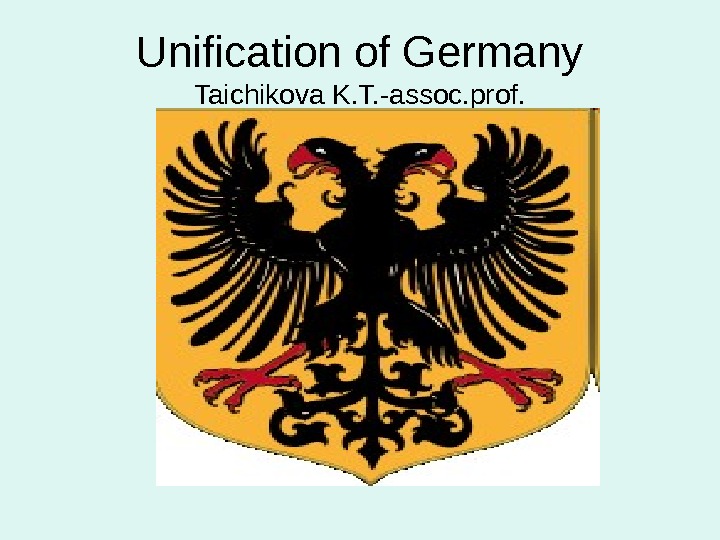
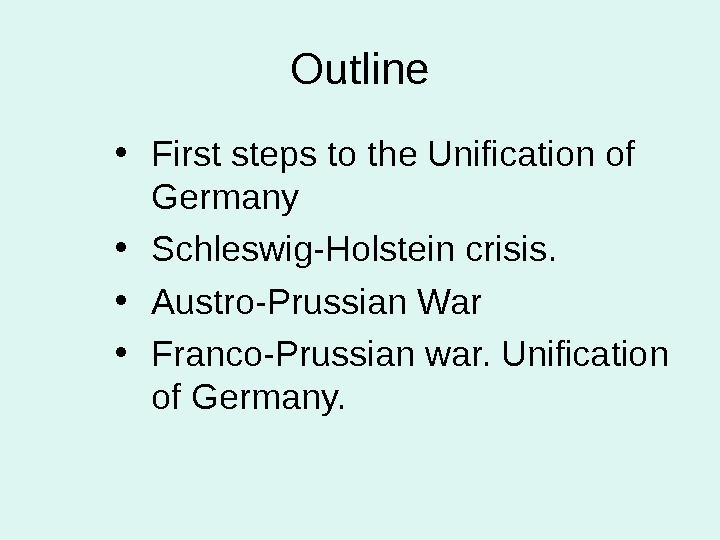
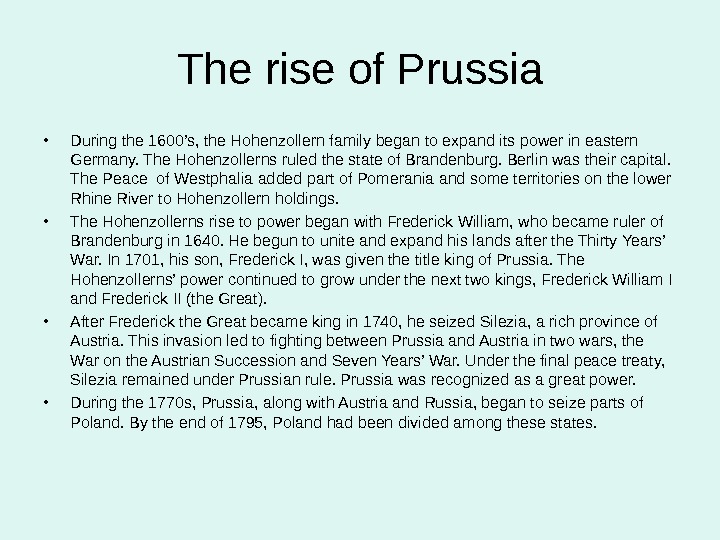
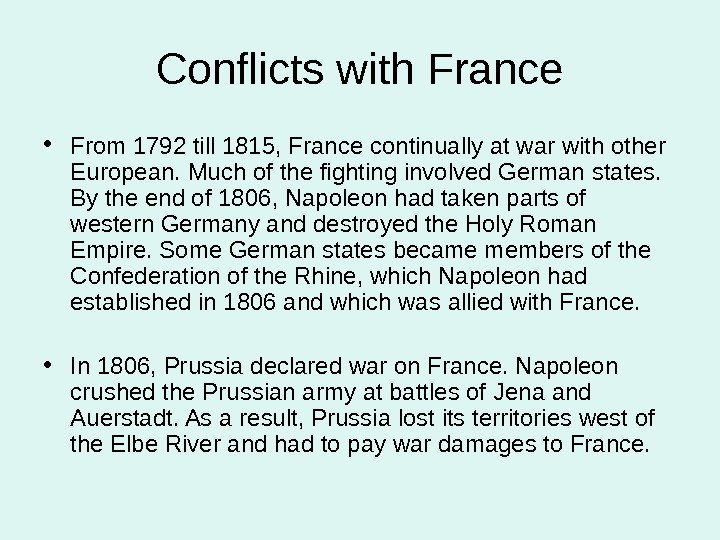
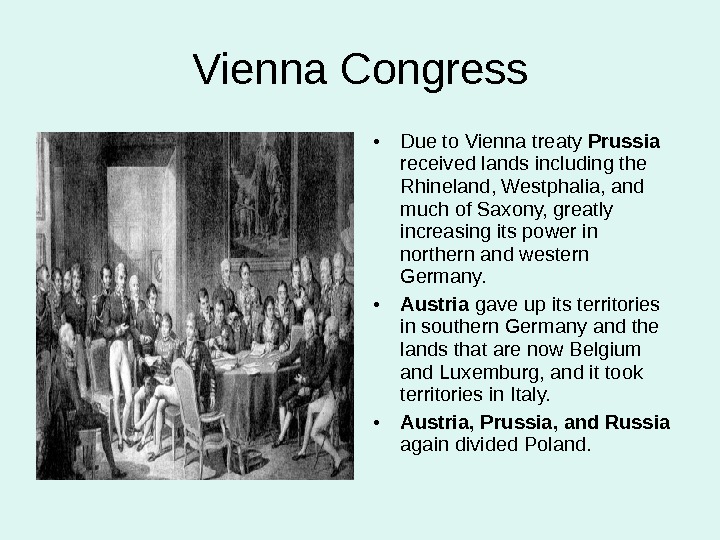
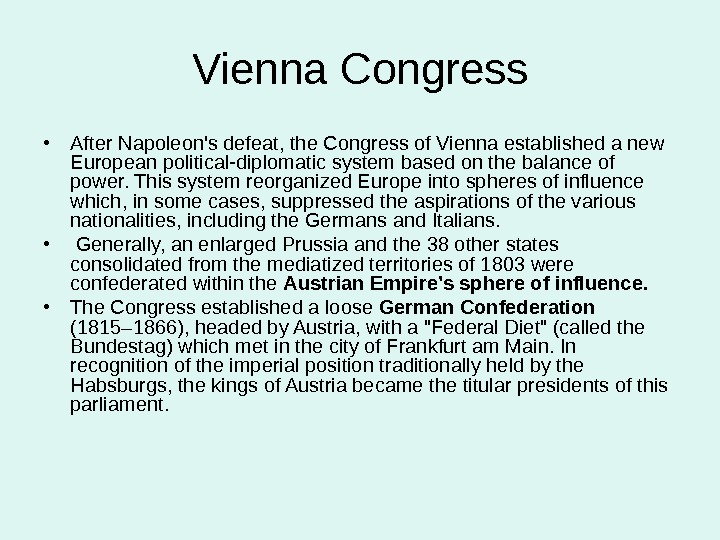
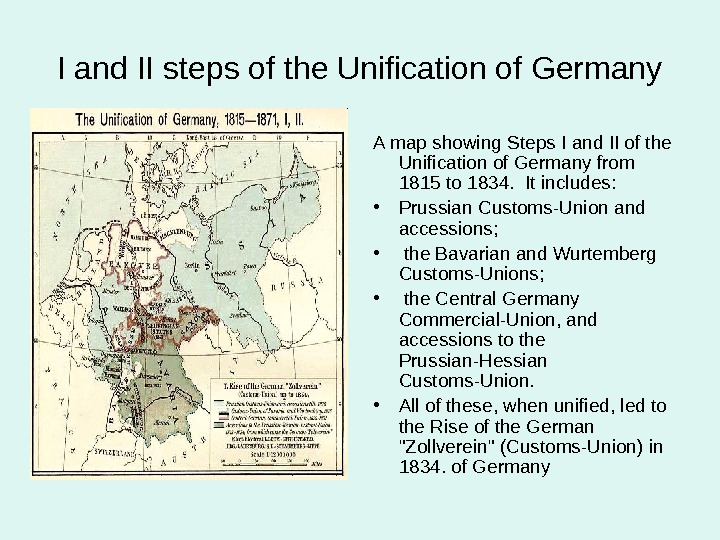
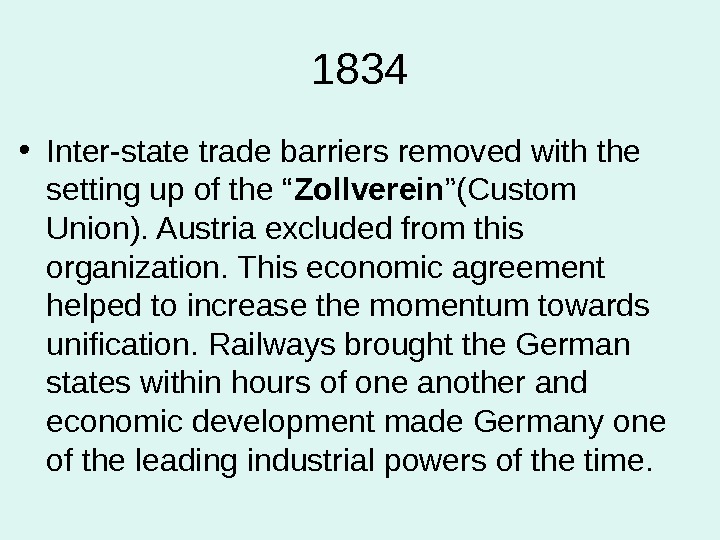
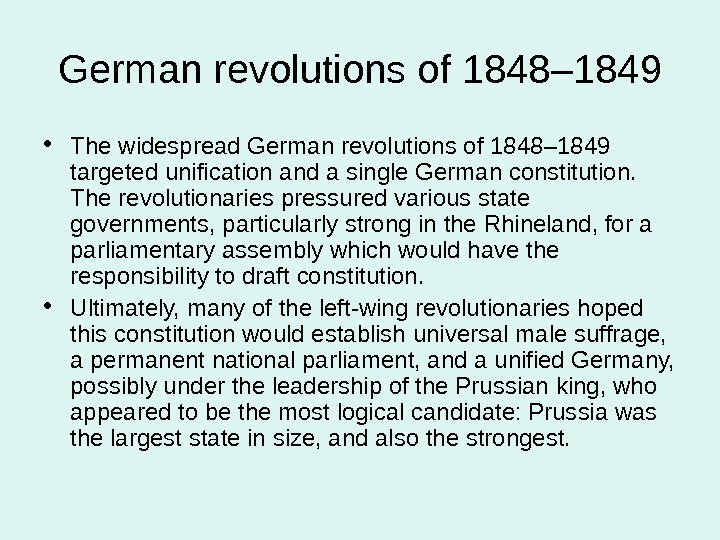
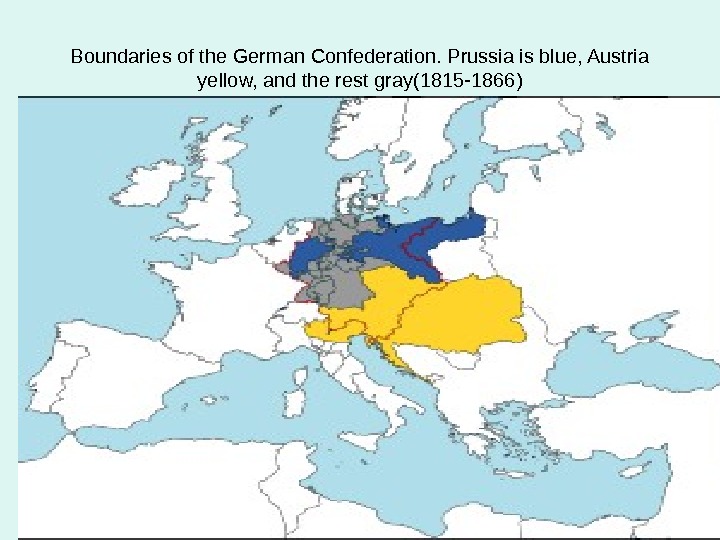
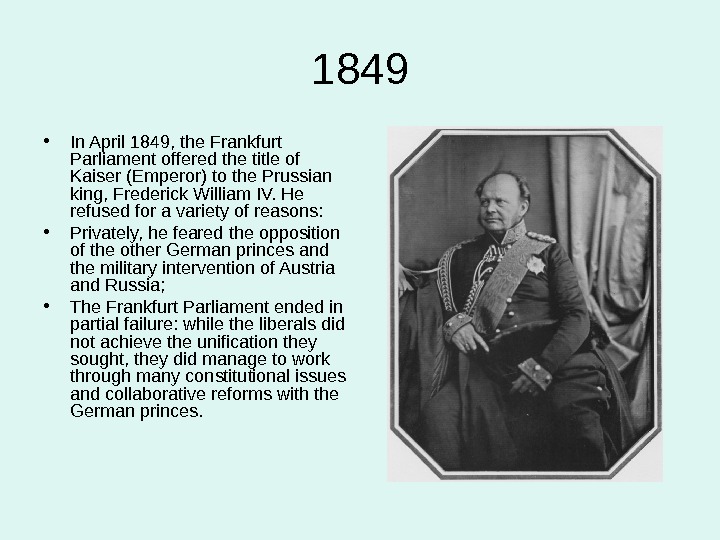
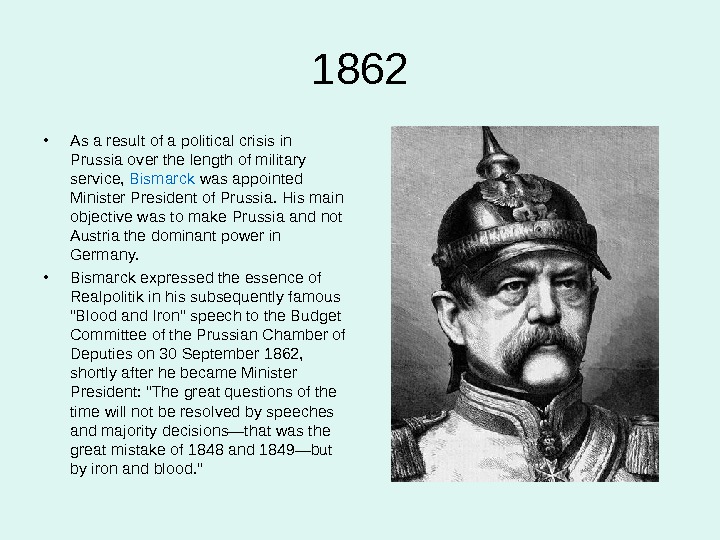
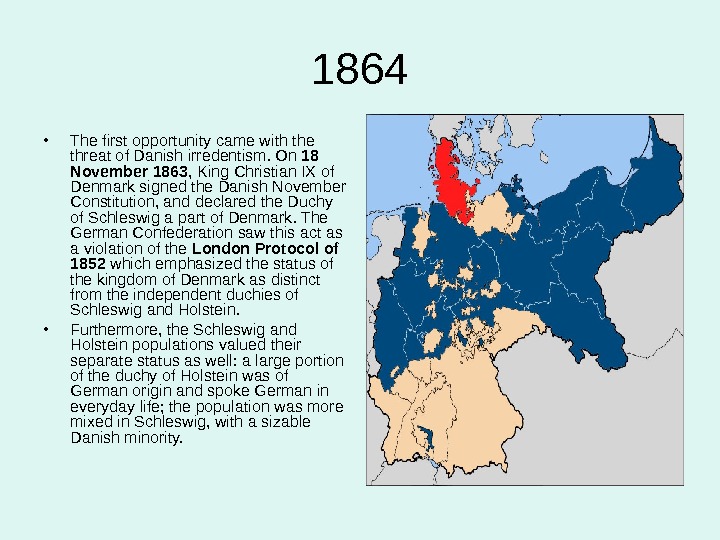
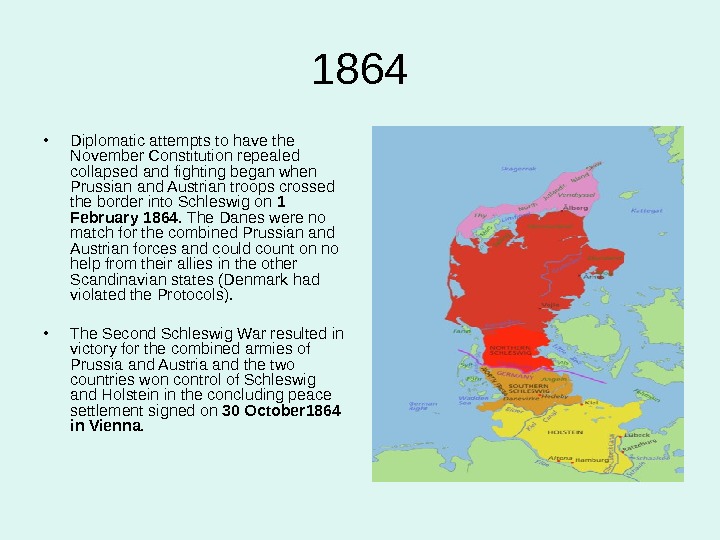
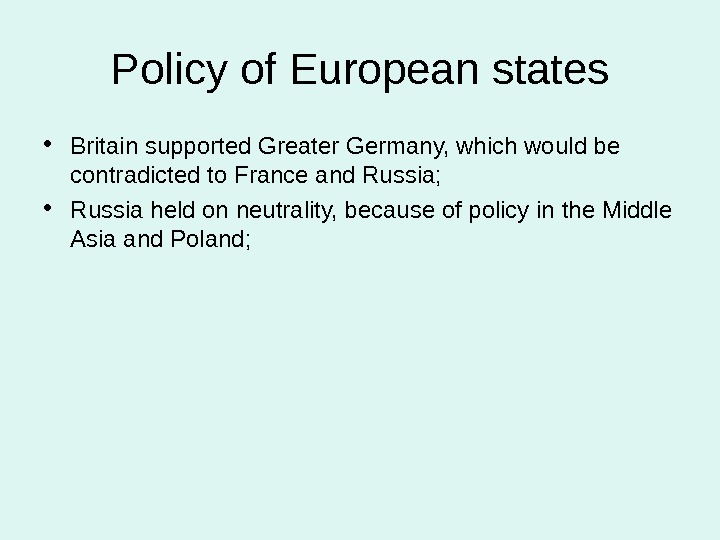
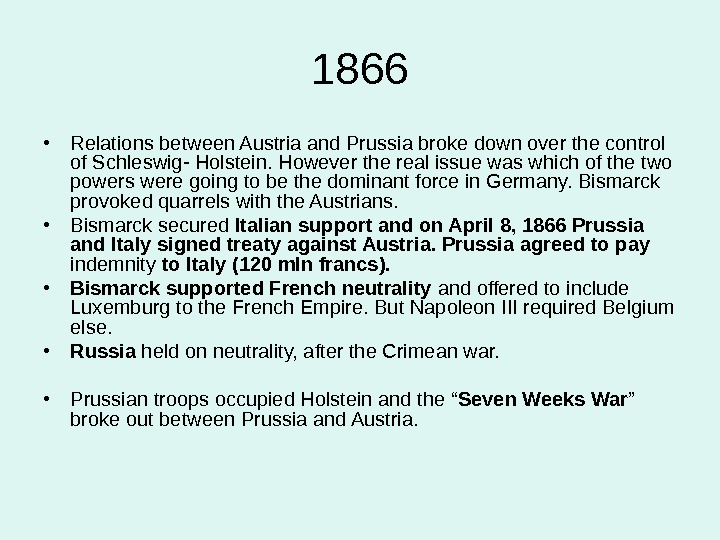
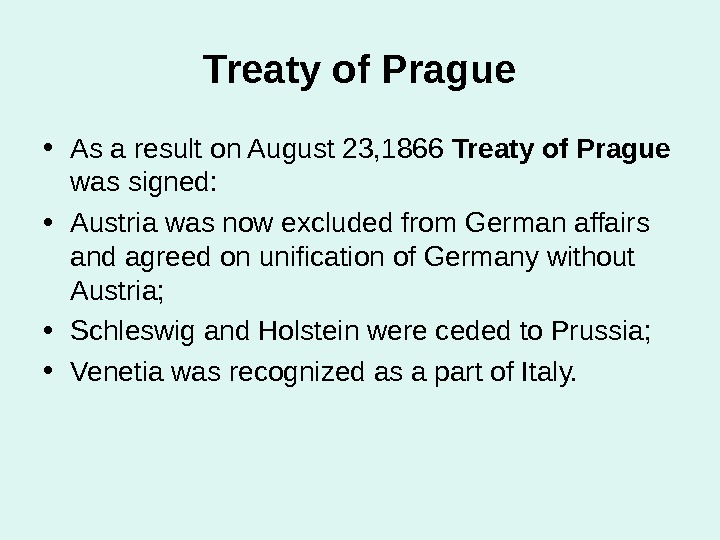
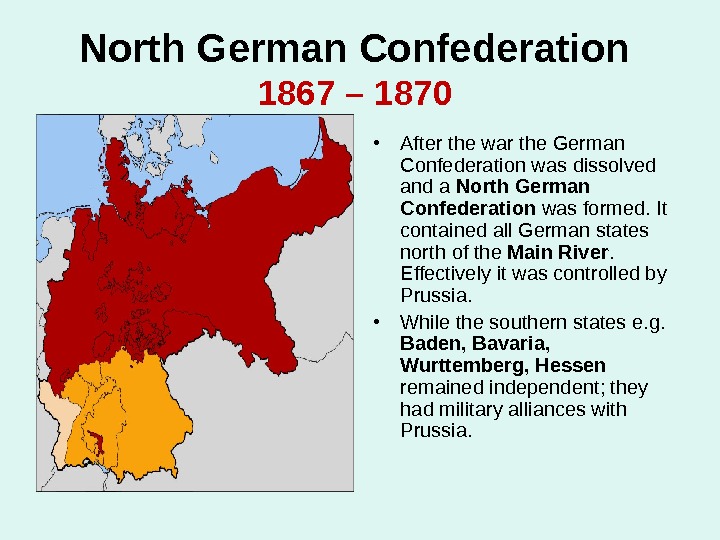
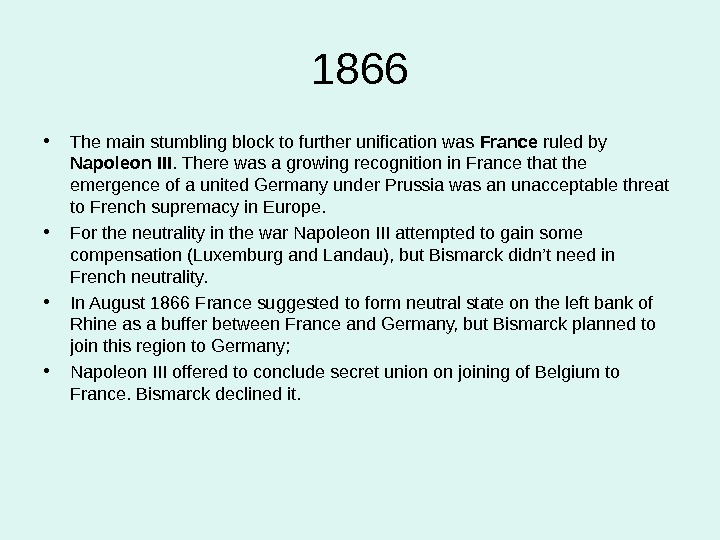
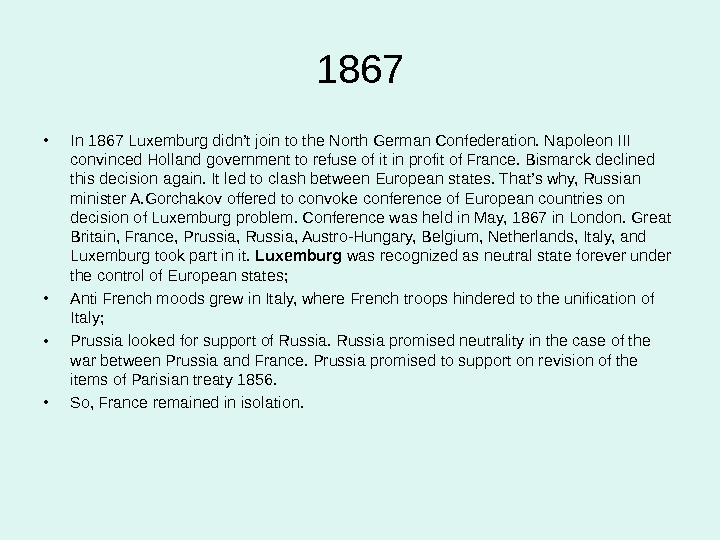
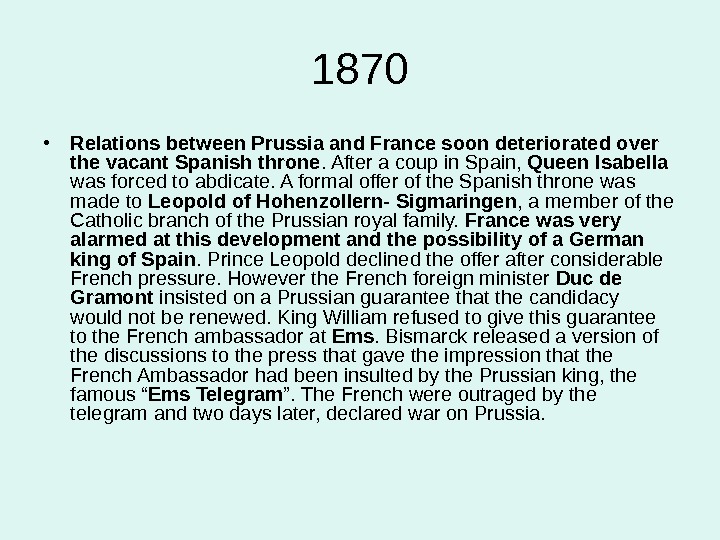
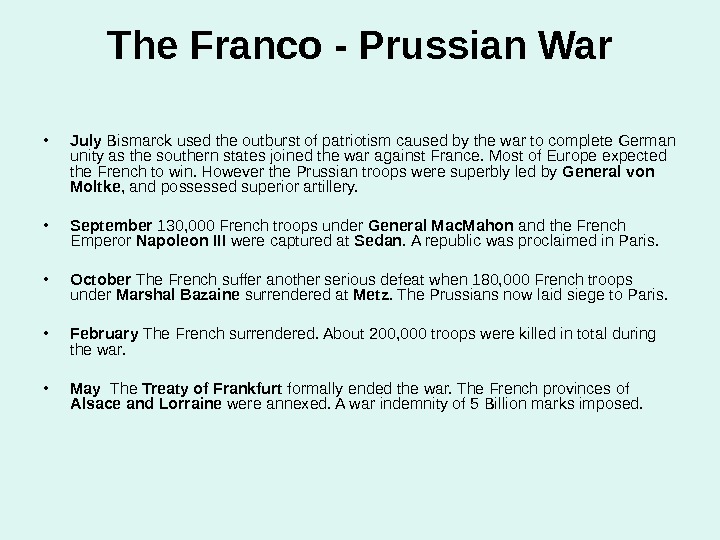
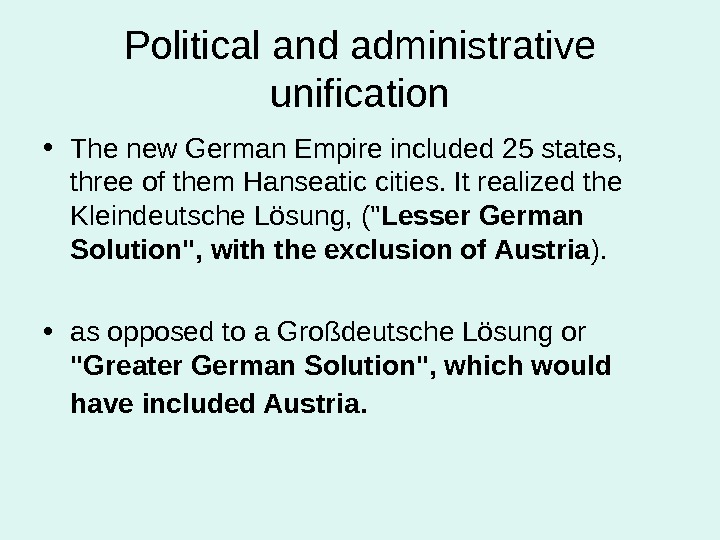
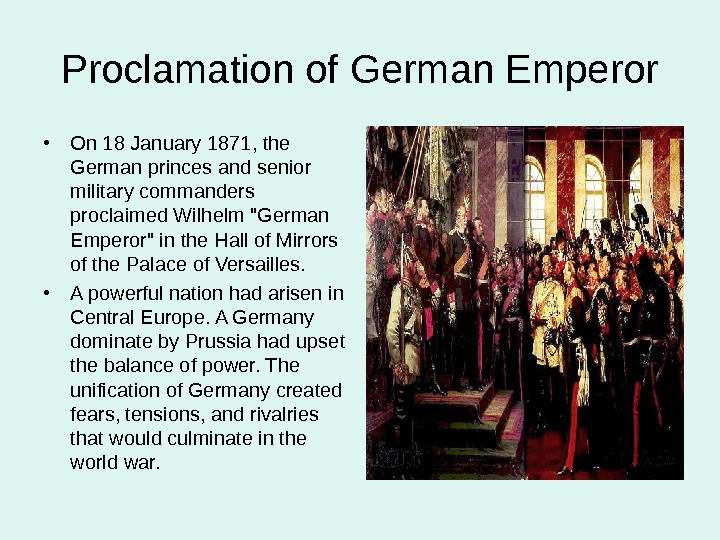

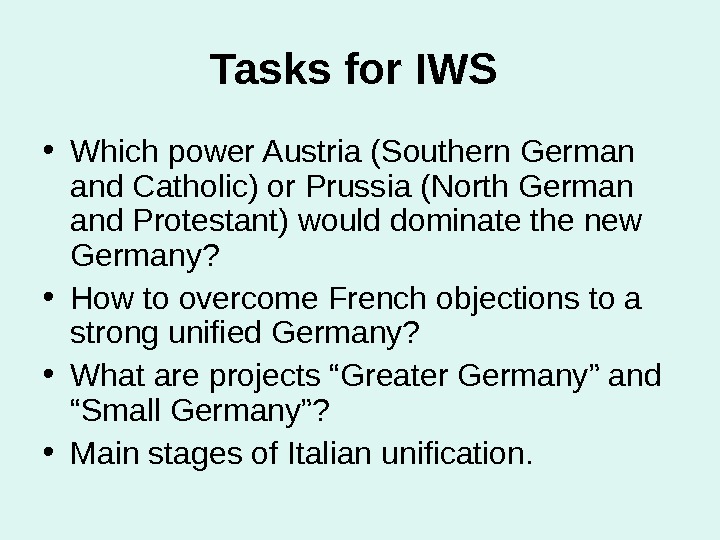
unification_of_germany.ppt
- Размер: 1.8 Mегабайта
- Количество слайдов: 26
Описание презентации Unification of Germany Taichikova K. T. -assoc. prof. по слайдам
 Unification of Germany Taichikova K. T. -assoc. prof.
Unification of Germany Taichikova K. T. -assoc. prof.
 Outline • First steps to the Unification of Germany • Schleswig-Holstein crisis. • Austro-Prussian War • Franco-Prussian war. Unification of Germany.
Outline • First steps to the Unification of Germany • Schleswig-Holstein crisis. • Austro-Prussian War • Franco-Prussian war. Unification of Germany.
 The rise of Prussia • During the 1600’s, the Hohenzollern family began to expand its power in eastern Germany. The Hohenzollerns ruled the state of Brandenburg. Berlin was their capital. The Peace of Westphalia added part of Pomerania and some territories on the lower Rhine River to Hohenzollern holdings. • The Hohenzollerns rise to power began with Frederick William, who became ruler of Brandenburg in 1640. He begun to unite and expand his lands after the Thirty Years’ War. In 1701, his son, Frederick I, was given the title king of Prussia. The Hohenzollerns’ power continued to grow under the next two kings, Frederick William I and Frederick II (the Great). • After Frederick the Great became king in 1740, he seized Silezia, a rich province of Austria. This invasion led to fighting between Prussia and Austria in two wars, the War on the Austrian Succession and Seven Years’ War. Under the final peace treaty, Silezia remained under Prussian rule. Prussia was recognized as a great power. • During the 1770 s, Prussia, along with Austria and Russia, began to seize parts of Poland. By the end of 1795, Poland had been divided among these states.
The rise of Prussia • During the 1600’s, the Hohenzollern family began to expand its power in eastern Germany. The Hohenzollerns ruled the state of Brandenburg. Berlin was their capital. The Peace of Westphalia added part of Pomerania and some territories on the lower Rhine River to Hohenzollern holdings. • The Hohenzollerns rise to power began with Frederick William, who became ruler of Brandenburg in 1640. He begun to unite and expand his lands after the Thirty Years’ War. In 1701, his son, Frederick I, was given the title king of Prussia. The Hohenzollerns’ power continued to grow under the next two kings, Frederick William I and Frederick II (the Great). • After Frederick the Great became king in 1740, he seized Silezia, a rich province of Austria. This invasion led to fighting between Prussia and Austria in two wars, the War on the Austrian Succession and Seven Years’ War. Under the final peace treaty, Silezia remained under Prussian rule. Prussia was recognized as a great power. • During the 1770 s, Prussia, along with Austria and Russia, began to seize parts of Poland. By the end of 1795, Poland had been divided among these states.
 Conflicts with France • From 1792 till 1815, France continually at war with other European. Much of the fighting involved German states. By the end of 1806, Napoleon had taken parts of western Germany and destroyed the Holy Roman Empire. Some German states became members of the Confederation of the Rhine, which Napoleon had established in 1806 and which was allied with France. • In 1806, Prussia declared war on France. Napoleon crushed the Prussian army at battles of Jena and Auerstadt. As a result, Prussia lost its territories west of the Elbe River and had to pay war damages to France.
Conflicts with France • From 1792 till 1815, France continually at war with other European. Much of the fighting involved German states. By the end of 1806, Napoleon had taken parts of western Germany and destroyed the Holy Roman Empire. Some German states became members of the Confederation of the Rhine, which Napoleon had established in 1806 and which was allied with France. • In 1806, Prussia declared war on France. Napoleon crushed the Prussian army at battles of Jena and Auerstadt. As a result, Prussia lost its territories west of the Elbe River and had to pay war damages to France.
 Vienna Congress • Due to Vienna treaty Prussia received lands including the Rhineland, Westphalia, and much of Saxony, greatly increasing its power in northern and western Germany. • Austria gave up its territories in southern Germany and the lands that are now Belgium and Luxemburg, and it took territories in Italy. • Austria, Prussia, and Russia again divided Poland.
Vienna Congress • Due to Vienna treaty Prussia received lands including the Rhineland, Westphalia, and much of Saxony, greatly increasing its power in northern and western Germany. • Austria gave up its territories in southern Germany and the lands that are now Belgium and Luxemburg, and it took territories in Italy. • Austria, Prussia, and Russia again divided Poland.
 Vienna Congress • After Napoleon’s defeat, the Congress of Vienna established a new European political-diplomatic system based on the balance of power. This system reorganized Europe into spheres of influence which, in some cases, suppressed the aspirations of the various nationalities, including the Germans and Italians. • Generally, an enlarged Prussia and the 38 other states consolidated from the mediatized territories of 1803 were confederated within the Austrian Empire’s sphere of influence. • The Congress established a loose German Confederation (1815– 1866), headed by Austria, with a «Federal Diet» (called the Bundestag) which met in the city of Frankfurt am Main. In recognition of the imperial position traditionally held by the Habsburgs, the kings of Austria became the titular presidents of this parliament.
Vienna Congress • After Napoleon’s defeat, the Congress of Vienna established a new European political-diplomatic system based on the balance of power. This system reorganized Europe into spheres of influence which, in some cases, suppressed the aspirations of the various nationalities, including the Germans and Italians. • Generally, an enlarged Prussia and the 38 other states consolidated from the mediatized territories of 1803 were confederated within the Austrian Empire’s sphere of influence. • The Congress established a loose German Confederation (1815– 1866), headed by Austria, with a «Federal Diet» (called the Bundestag) which met in the city of Frankfurt am Main. In recognition of the imperial position traditionally held by the Habsburgs, the kings of Austria became the titular presidents of this parliament.
 I and II steps of the Unification of Germany A map showing Steps I and II of the Unification of Germany from 1815 to 1834. It includes: • Prussian Customs-Union and accessions; • the Bavarian and Wurtemberg Customs-Unions; • the Central Germany Commercial-Union, and accessions to the Prussian-Hessian Customs-Union. • All of these, when unified, led to the Rise of the German «Zollverein» (Customs-Union) in 1834. of Germany
I and II steps of the Unification of Germany A map showing Steps I and II of the Unification of Germany from 1815 to 1834. It includes: • Prussian Customs-Union and accessions; • the Bavarian and Wurtemberg Customs-Unions; • the Central Germany Commercial-Union, and accessions to the Prussian-Hessian Customs-Union. • All of these, when unified, led to the Rise of the German «Zollverein» (Customs-Union) in 1834. of Germany
 1834 • Inter-state trade barriers removed with the setting up of the “ Zollverein ”(Custom Union). Austria excluded from this organization. This economic agreement helped to increase the momentum towards unification. Railways brought the German states within hours of one another and economic development made Germany one of the leading industrial powers of the time.
1834 • Inter-state trade barriers removed with the setting up of the “ Zollverein ”(Custom Union). Austria excluded from this organization. This economic agreement helped to increase the momentum towards unification. Railways brought the German states within hours of one another and economic development made Germany one of the leading industrial powers of the time.
 German revolutions of 1848– 1849 • The widespread German revolutions of 1848– 1849 targeted unification and a single German constitution. The revolutionaries pressured various state governments, particularly strong in the Rhineland, for a parliamentary assembly which would have the responsibility to draft constitution. • Ultimately, many of the left-wing revolutionaries hoped this constitution would establish universal male suffrage, a permanent national parliament, and a unified Germany, possibly under the leadership of the Prussian king, who appeared to be the most logical candidate: Prussia was the largest state in size, and also the strongest.
German revolutions of 1848– 1849 • The widespread German revolutions of 1848– 1849 targeted unification and a single German constitution. The revolutionaries pressured various state governments, particularly strong in the Rhineland, for a parliamentary assembly which would have the responsibility to draft constitution. • Ultimately, many of the left-wing revolutionaries hoped this constitution would establish universal male suffrage, a permanent national parliament, and a unified Germany, possibly under the leadership of the Prussian king, who appeared to be the most logical candidate: Prussia was the largest state in size, and also the strongest.
 Boundaries of the German Confederation. Prussia is blue, Austria yellow, and the rest gray(1815 -1866)
Boundaries of the German Confederation. Prussia is blue, Austria yellow, and the rest gray(1815 -1866)
 184 9 • In April 1849, the Frankfurt Parliament offered the title of Kaiser (Emperor) to the Prussian king, Frederick William IV. He refused for a variety of reasons: • Privately, he feared the opposition of the other German princes and the military intervention of Austria and Russia; • The Frankfurt Parliament ended in partial failure: while the liberals did not achieve the unification they sought, they did manage to work through many constitutional issues and collaborative reforms with the German princes.
184 9 • In April 1849, the Frankfurt Parliament offered the title of Kaiser (Emperor) to the Prussian king, Frederick William IV. He refused for a variety of reasons: • Privately, he feared the opposition of the other German princes and the military intervention of Austria and Russia; • The Frankfurt Parliament ended in partial failure: while the liberals did not achieve the unification they sought, they did manage to work through many constitutional issues and collaborative reforms with the German princes.
 1862 • As a result of a political crisis in Prussia over the length of military service, Bismarck was appointed Minister President of Prussia. His main objective was to make Prussia and not Austria the dominant power in Germany. • Bismarck expressed the essence of Realpolitik in his subsequently famous «Blood and Iron» speech to the Budget Committee of the Prussian Chamber of Deputies on 30 September 1862, shortly after he became Minister President: «The great questions of the time will not be resolved by speeches and majority decisions—that was the great mistake of 1848 and 1849—but by iron and blood. «
1862 • As a result of a political crisis in Prussia over the length of military service, Bismarck was appointed Minister President of Prussia. His main objective was to make Prussia and not Austria the dominant power in Germany. • Bismarck expressed the essence of Realpolitik in his subsequently famous «Blood and Iron» speech to the Budget Committee of the Prussian Chamber of Deputies on 30 September 1862, shortly after he became Minister President: «The great questions of the time will not be resolved by speeches and majority decisions—that was the great mistake of 1848 and 1849—but by iron and blood. «
 1864 • The first opportunity came with the threat of Danish irredentism. On 18 November 1863, King Christian IX of Denmark signed the Danish November Constitution, and declared the Duchy of Schleswig a part of Denmark. The German Confederation saw this act as a violation of the London Protocol of 1852 which emphasized the status of the kingdom of Denmark as distinct from the independent duchies of Schleswig and Holstein. • Furthermore, the Schleswig and Holstein populations valued their separate status as well: a large portion of the duchy of Holstein was of German origin and spoke German in everyday life; the population was more mixed in Schleswig, with a sizable Danish minority.
1864 • The first opportunity came with the threat of Danish irredentism. On 18 November 1863, King Christian IX of Denmark signed the Danish November Constitution, and declared the Duchy of Schleswig a part of Denmark. The German Confederation saw this act as a violation of the London Protocol of 1852 which emphasized the status of the kingdom of Denmark as distinct from the independent duchies of Schleswig and Holstein. • Furthermore, the Schleswig and Holstein populations valued their separate status as well: a large portion of the duchy of Holstein was of German origin and spoke German in everyday life; the population was more mixed in Schleswig, with a sizable Danish minority.
 1864 • Diplomatic attempts to have the November Constitution repealed collapsed and fighting began when Prussian and Austrian troops crossed the border into Schleswig on 1 February 1864. The Danes were no match for the combined Prussian and Austrian forces and could count on no help from their allies in the other Scandinavian states (Denmark had violated the Protocols). • The Second Schleswig War resulted in victory for the combined armies of Prussia and Austria and the two countries won control of Schleswig and Holstein in the concluding peace settlement signed on 30 October 1864 in Vienna.
1864 • Diplomatic attempts to have the November Constitution repealed collapsed and fighting began when Prussian and Austrian troops crossed the border into Schleswig on 1 February 1864. The Danes were no match for the combined Prussian and Austrian forces and could count on no help from their allies in the other Scandinavian states (Denmark had violated the Protocols). • The Second Schleswig War resulted in victory for the combined armies of Prussia and Austria and the two countries won control of Schleswig and Holstein in the concluding peace settlement signed on 30 October 1864 in Vienna.
 Policy of European states • Britain supported Greater Germany, which would be contradicted to France and Russia; • Russia held on neutrality, because of policy in the Middle Asia and Poland;
Policy of European states • Britain supported Greater Germany, which would be contradicted to France and Russia; • Russia held on neutrality, because of policy in the Middle Asia and Poland;
 1866 • Relations between Austria and Prussia broke down over the control of Schleswig- Holstein. However the real issue was which of the two powers were going to be the dominant force in Germany. Bismarck provoked quarrels with the Austrians. • Bismarck secured Italian support and on April 8, 1866 Prussia and Italy signed treaty against Austria. Prussia agreed to pay indemnity to Italy (120 mln francs). • Bismarck supported French neutrality and offered to include Luxemburg to the French Empire. But Napoleon III required Belgium else. • Russia held on neutrality, after the Crimean war. • Prussian troops occupied Holstein and the “ Seven Weeks War ” broke out between Prussia and Austria.
1866 • Relations between Austria and Prussia broke down over the control of Schleswig- Holstein. However the real issue was which of the two powers were going to be the dominant force in Germany. Bismarck provoked quarrels with the Austrians. • Bismarck secured Italian support and on April 8, 1866 Prussia and Italy signed treaty against Austria. Prussia agreed to pay indemnity to Italy (120 mln francs). • Bismarck supported French neutrality and offered to include Luxemburg to the French Empire. But Napoleon III required Belgium else. • Russia held on neutrality, after the Crimean war. • Prussian troops occupied Holstein and the “ Seven Weeks War ” broke out between Prussia and Austria.
 Treaty of Prague • As a result on August 23, 1866 Treaty of Prague was signed: • Austria was now excluded from German affairs and agreed on unification of Germany without Austria; • Schleswig and Holstein were ceded to Prussia; • Venetia was recognized as a part of Italy.
Treaty of Prague • As a result on August 23, 1866 Treaty of Prague was signed: • Austria was now excluded from German affairs and agreed on unification of Germany without Austria; • Schleswig and Holstein were ceded to Prussia; • Venetia was recognized as a part of Italy.
 North German Confederation 1867 – 1870 • After the war the German Confederation was dissolved and a North German Confederation was formed. It contained all German states north of the Main River. Effectively it was controlled by Prussia. • While the southern states e. g. Baden, Bavaria, Wurttemberg, Hessen remained independent; they had military alliances with Prussia.
North German Confederation 1867 – 1870 • After the war the German Confederation was dissolved and a North German Confederation was formed. It contained all German states north of the Main River. Effectively it was controlled by Prussia. • While the southern states e. g. Baden, Bavaria, Wurttemberg, Hessen remained independent; they had military alliances with Prussia.
 18 66 • The main stumbling block to further unification was France ruled by Napoleon III. There was a growing recognition in France that the emergence of a united Germany under Prussia was an unacceptable threat to French supremacy in Europe. • For the neutrality in the war Napoleon III attempted to gain some compensation (Luxemburg and Landau), but Bismarck didn’t need in French neutrality. • In August 1866 France suggested to form neutral state on the left bank of Rhine as a buffer between France and Germany, but Bismarck planned to join this region to Germany; • Napoleon III offered to conclude secret union on joining of Belgium to France. Bismarck declined it.
18 66 • The main stumbling block to further unification was France ruled by Napoleon III. There was a growing recognition in France that the emergence of a united Germany under Prussia was an unacceptable threat to French supremacy in Europe. • For the neutrality in the war Napoleon III attempted to gain some compensation (Luxemburg and Landau), but Bismarck didn’t need in French neutrality. • In August 1866 France suggested to form neutral state on the left bank of Rhine as a buffer between France and Germany, but Bismarck planned to join this region to Germany; • Napoleon III offered to conclude secret union on joining of Belgium to France. Bismarck declined it.
 1867 • In 1867 Luxemburg didn’t join to the North German Confederation. Napoleon III convinced Holland government to refuse of it in profit of France. Bismarck declined this decision again. It led to clash between European states. That’s why, Russian minister A. Gorchakov offered to convoke conference of European countries on decision of Luxemburg problem. Conference was held in May, 1867 in London. Great Britain, France, Prussia, Russia, Austro-Hungary, Belgium, Netherlands, Italy, and Luxemburg took part in it. Luxemburg was recognized as neutral state forever under the control of European states; • Anti French moods grew in Italy, where French troops hindered to the unification of Italy; • Prussia looked for support of Russia promised neutrality in the case of the war between Prussia and France. Prussia promised to support on revision of the items of Parisian treaty 1856. • So, France remained in isolation.
1867 • In 1867 Luxemburg didn’t join to the North German Confederation. Napoleon III convinced Holland government to refuse of it in profit of France. Bismarck declined this decision again. It led to clash between European states. That’s why, Russian minister A. Gorchakov offered to convoke conference of European countries on decision of Luxemburg problem. Conference was held in May, 1867 in London. Great Britain, France, Prussia, Russia, Austro-Hungary, Belgium, Netherlands, Italy, and Luxemburg took part in it. Luxemburg was recognized as neutral state forever under the control of European states; • Anti French moods grew in Italy, where French troops hindered to the unification of Italy; • Prussia looked for support of Russia promised neutrality in the case of the war between Prussia and France. Prussia promised to support on revision of the items of Parisian treaty 1856. • So, France remained in isolation.
 1870 • Relations between Prussia and France soon deteriorated over the vacant Spanish throne. After a coup in Spain, Queen Isabella was forced to abdicate. A formal offer of the Spanish throne was made to Leopold of Hohenzollern- Sigmaringen , a member of the Catholic branch of the Prussian royal family. France was very alarmed at this development and the possibility of a German king of Spain. Prince Leopold declined the offer after considerable French pressure. However the French foreign minister Duc de Gramont insisted on a Prussian guarantee that the candidacy would not be renewed. King William refused to give this guarantee to the French ambassador at Ems. Bismarck released a version of the discussions to the press that gave the impression that the French Ambassador had been insulted by the Prussian king, the famous “ Ems Telegram ”. The French were outraged by the telegram and two days later, declared war on Prussia.
1870 • Relations between Prussia and France soon deteriorated over the vacant Spanish throne. After a coup in Spain, Queen Isabella was forced to abdicate. A formal offer of the Spanish throne was made to Leopold of Hohenzollern- Sigmaringen , a member of the Catholic branch of the Prussian royal family. France was very alarmed at this development and the possibility of a German king of Spain. Prince Leopold declined the offer after considerable French pressure. However the French foreign minister Duc de Gramont insisted on a Prussian guarantee that the candidacy would not be renewed. King William refused to give this guarantee to the French ambassador at Ems. Bismarck released a version of the discussions to the press that gave the impression that the French Ambassador had been insulted by the Prussian king, the famous “ Ems Telegram ”. The French were outraged by the telegram and two days later, declared war on Prussia.
 The Franco — Prussian War • July Bismarck used the outburst of patriotism caused by the war to complete German unity as the southern states joined the war against France. Most of Europe expected the French to win. However the Prussian troops were superbly led by General von Moltke , and possessed superior artillery. • September 130, 000 French troops under General Mac. Mahon and the French Emperor Napoleon III were captured at Sedan. A republic was proclaimed in Paris. • October The French suffer another serious defeat when 180, 000 French troops under Marshal Bazaine surrendered at Metz. The Prussians now laid siege to Paris. • February The French surrendered. About 200, 000 troops were killed in total during the war. • May The Treaty of Frankfurt formally ended the war. The French provinces of Alsace and Lorraine were annexed. A war indemnity of 5 Billion marks imposed.
The Franco — Prussian War • July Bismarck used the outburst of patriotism caused by the war to complete German unity as the southern states joined the war against France. Most of Europe expected the French to win. However the Prussian troops were superbly led by General von Moltke , and possessed superior artillery. • September 130, 000 French troops under General Mac. Mahon and the French Emperor Napoleon III were captured at Sedan. A republic was proclaimed in Paris. • October The French suffer another serious defeat when 180, 000 French troops under Marshal Bazaine surrendered at Metz. The Prussians now laid siege to Paris. • February The French surrendered. About 200, 000 troops were killed in total during the war. • May The Treaty of Frankfurt formally ended the war. The French provinces of Alsace and Lorraine were annexed. A war indemnity of 5 Billion marks imposed.
 Political and administrative unification • The new German Empire included 25 states, three of them Hanseatic cities. It realized the Kleindeutsche Lösung, (» Lesser German Solution», with the exclusion of Austria ). • as opposed to a Großdeutsche Lösung or «Greater German Solution», which would have included Austria.
Political and administrative unification • The new German Empire included 25 states, three of them Hanseatic cities. It realized the Kleindeutsche Lösung, (» Lesser German Solution», with the exclusion of Austria ). • as opposed to a Großdeutsche Lösung or «Greater German Solution», which would have included Austria.
 Proclamation of German Emperor • On 18 January 1871, the German princes and senior military commanders proclaimed Wilhelm «German Emperor» in the Hall of Mirrors of the Palace of Versailles. • A powerful nation had arisen in Central Europe. A Germany dominate by Prussia had upset the balance of power. The unification of Germany created fears, tensions, and rivalries that would culminate in the world war.
Proclamation of German Emperor • On 18 January 1871, the German princes and senior military commanders proclaimed Wilhelm «German Emperor» in the Hall of Mirrors of the Palace of Versailles. • A powerful nation had arisen in Central Europe. A Germany dominate by Prussia had upset the balance of power. The unification of Germany created fears, tensions, and rivalries that would culminate in the world war.
 Results of the War • The war marked the end of French military domination in Europe. The new German Empire emerged as Europe’s foremost military power. Prussia dominated this new German state. • The war and its aftermath created great bitterness between the two countries and sowed the seeds for the First World War. French resentment at the loss of Alsace-Lorraine and the desire for revenge dominated French politics for fifty years. • As a result of the war French troops guarding the Pope in Rome were forced to withdraw and Italian unification was completed.
Results of the War • The war marked the end of French military domination in Europe. The new German Empire emerged as Europe’s foremost military power. Prussia dominated this new German state. • The war and its aftermath created great bitterness between the two countries and sowed the seeds for the First World War. French resentment at the loss of Alsace-Lorraine and the desire for revenge dominated French politics for fifty years. • As a result of the war French troops guarding the Pope in Rome were forced to withdraw and Italian unification was completed.
 Tasks for IWS • Which power Austria (Southern German and Catholic) or Prussia (North German and Protestant) would dominate the new Germany? • How to overcome French objections to a strong unified Germany? • What are projects “Greater Germany” and “Small Germany”? • Main stages of Italian unification.
Tasks for IWS • Which power Austria (Southern German and Catholic) or Prussia (North German and Protestant) would dominate the new Germany? • How to overcome French objections to a strong unified Germany? • What are projects “Greater Germany” and “Small Germany”? • Main stages of Italian unification.

